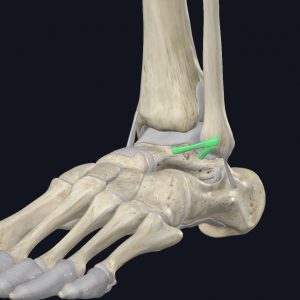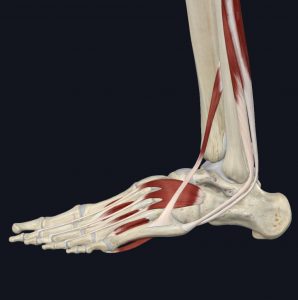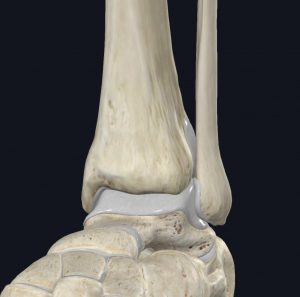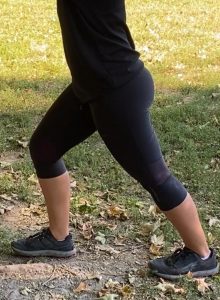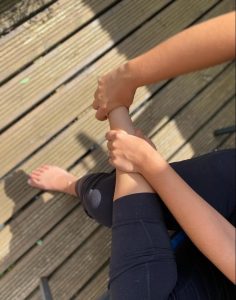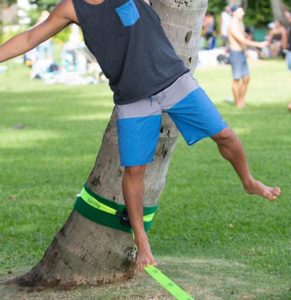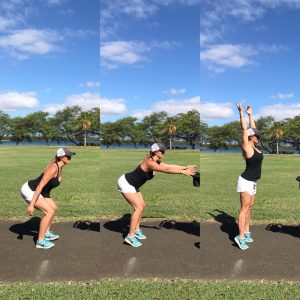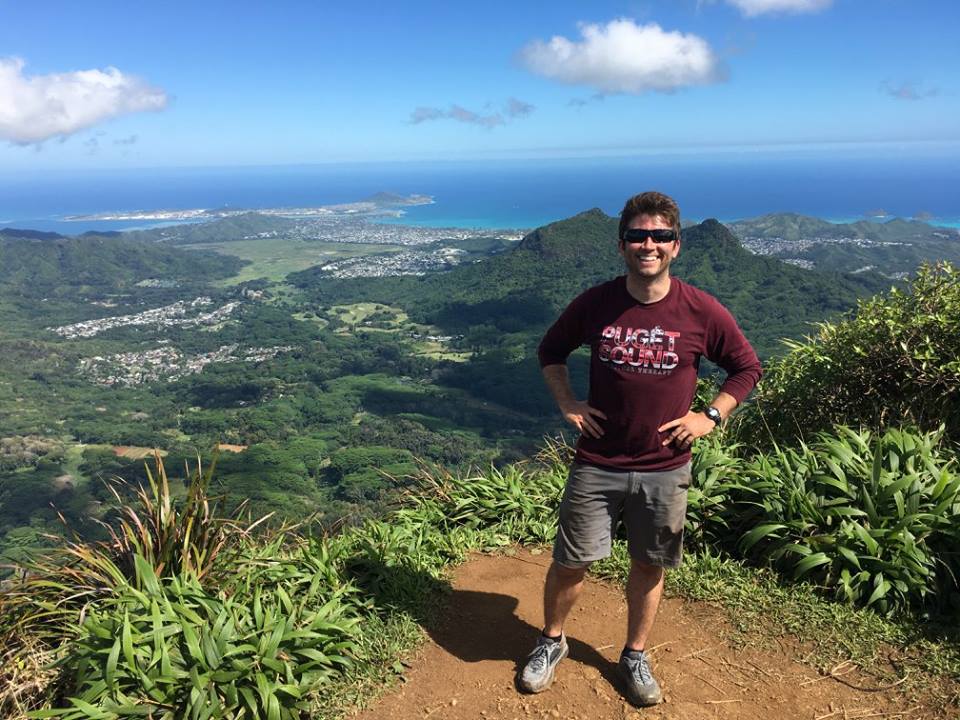
Hiking trails can be risky but rewarding. Some of the best vista points require traversing steep and rocky trails!
But, every hiker’s worst nightmare is an injury on those types of trails. One of the most common injuries on the trail is an ankle sprain, which is why many people opt to wear high-top hiking boots.
But are high-top hiking boots the best way to protect your ankles from rolls and breaks?
How Do Ankle Sprains Happen?
Ankle sprains, or “rolling the ankle,” happen when the foot turns inwards in response to a sudden surface change, faulty cutting and landing mechanics, or excessive force. The ligaments on the outside of the ankle stretch, stressing the soft tissue and causing pain and sometimes tears.
- The anterior talofibular ligament (ATFL), the most commonly sprained ligament of the ankle (highlighted) | Image courtesy of Complete Anatomy
If the outside structures are stressed enough, it may result in a muscular injury as well. This is called a muscle strain. The muscles typically affected are the peroneals, which are also located on the outside of the foot and ankle.
- The intricate musculature on the outer region of the foot and ankle | Image courtesy of Complete Anatomy
If there is enough force present, the ankle can roll to the point of a bone break. The two bones involved are called the tibia and fibula. Sometimes an avulsion fracture can happen, which is when the peroneal muscle breaks part of the bone away from its attachment site on the fifth metatarsal of the foot.
- A close-up on the tibia and fibula, the two bones of the shin that are commonly broken with severe ankle rolls | Image courtesy of Complete Anatomy
Ankle sprains are very common among hikers because of the rough terrain. Ankles require mobility and strength to adapt to the surfaces they traverse. Roots, rocks, and divots on the ground can pop up all over the trail, so the body has to be ready to react to the surface changes. Caught off-guard, you’re at risk for an ankle sprain.
Do My High-Top Hiking Boots Work?
High top shoe wear isn’t unique to hikers. Basketball players also use high-top shoes in an attempt to protect their ankles. Still, one study found that 78% of basketball players still roll their ankle in a two-season time span. (2)
High-Top Hiking Boots Might Not Protect Your Ankle
There was a study published in the Journal of Foot and Ankle Research that showed surprising results. This study observed the amount of ankle inversion (rolling ankle motion) that happens with jump-landing. If you’re an avid hiker, you know that some trails require hopping over streams, jumping down from awkward landings, or controlled descents down a scramble. (1)
The result showed no difference in rolling ankle motions between high and low-top shoes. This means that the high-top shoes did not provide any external reinforcement of the ankle to stabilize it. There are factors that could change outcomes, like tightening the laces or well-fit shoes. However, in this study, the difference was negligible.
The more shocking result from the study is that high-top shoes can actually be detrimental to muscle activity needed to stabilize the ankle. There was a delayed reaction of the peroneal muscles which are necessary to pull the ankle out of the rolling motion. The reason isn’t clear, but this finding agrees with other previous studies which have found inhibitory effects of ankle bracing because of the body’s dependence on the external structure. (3)
This means that high-top shoe wear and bracing could actually increase your chance of an ankle sprain!
Keep in mind that this is not a universal statement. Many studies have discussed how external reinforcement can negatively affect muscle recruitment, but they could help in some cases. If you’re not sure, give JACO Rehab a call for a free 10-minute evaluation.
If you can’t rely on bracing and external reinforcement to help protect you, what can you rely on?
How Hikers Can Prevent Ankle Sprains
Joint mobility, muscle strength, and reaction time are huge factors in preventing ankle sprains.
By increasing your ankle’s mobility, you can withstand more movement (both expected and unexpected) before a ligament or muscle catches. Stiff ankles hit movement boundaries sooner than flexible ones. However, stretching alone can’t prevent injury. Flexible ankles roll, too.
Strengthening the muscles around your ankle can reinforce the joint with active stability. That means muscles can correct ankle movement in any position it’s in. The most stable ankle can react quickly to unexpected events, like stepping in a hole or landing on a root. If a muscle is strong and quick enough, it can keep the ankle from rolling too far and reposition the ankle without injury.
If you want longevity on the trail, you’ve got to work on reinforcing your ankle from the inside, not just rely on external factors.
Your Knees and Hips Can Help, Too
Your ankles don’t act alone. The whole body works together.
By strengthening your core, hips, and knees, you can help keep the rest of the leg stable which helps out the ankle. Weakness up the leg can leave the ankle vulnerable. Other muscles, like the glutes, can limit rotational force in the leg when turning and pivoting. Quads and glutes can work together to absorb force during quick changes in direction. Without those muscles helping, all the force goes to one place – don’t let that be your ankle.
3 Ways Hikers Should Train Their Ankles
Here are the top three things hikers should do to protect their ankles from injury.
1. Keep Your Ankles and Feet Mobile
Make sure your ankles move well so that they can adapt to surfaces. Stretch them in, out, up, and down to make sure they are exposed to all directions frequently.
- Calf Stretch – 30 seconds with knee straight and knee bent.
- Seated Ankle/Foot Mobility – Spend time stretching the foot inward, outward, and downward.
Your feet are important to move, too. The foot is composed of multiple little bones that move somewhat independently, but are joined by ligaments and soft tissue. Keeping those foot bones flexible can help out the ankle when adapting to uneven surfaces.
2. Strengthen Your Ankles and Feet
Some of the best ways to strengthen your ankles and feet are to practice balancing. You can practice in multiple different conditions:
- Shoes on or off
- On hard floor or on grass
- Eyes open or eyes closed
- On tip-toes or on flat feet
- Multitasking while throwing a ball or talking to a partner
- Our physical therapists do some seriously difficult balance training on the slack line!
Although it’s not the traditional way most people think of strengthening, it does make the ankle and foot work hard. They’re reacting to every little sway in the body, preventing you from falling over. And, if you’re working hard, you may even start to feel work happening in other places like your quad and glute muscles. Your entire body is involved in stabilizing your ankle.
3. Strengthen Up The Chain
Don’t just focus on the ankle. Your entire leg and trunk are responsible for stabilizing joints.
- Try some squat jumps (or squat to tiptoes) for full-body engagement. If you’re jumping, try doing 10 sideways, forward, and 90 degree turn jumps!
Perform exercises that have you challenging your quads, hamstrings, glutes, hip flexors, and abdominals in different ways. Exercises that involve jumping, cutting, or turning are excellent to get the entire body moving in ways that require coordination from all muscles. And, they’re more transferable to hiking!
Rely More On Your Own Ability
Hikers – don’t buy fancy braces and shoes. The best way to prevent ankle sprains on the trail is to train your body!
You’re better off training your joints and muscles to prevent injury rather than depending on external factors.
- Reinforce your ankles by keeping them flexible and strong.
- Get other muscles involved to offload force.
- Improve reaction time by practicing your balancing skills.
Most of all, teach your body how to fend for itself.
If you need guidance on how to start your own injury prevention program for hiking, visit JACO Rehab! We host injury prevention sessions at the Kapolei Clinic on Saturdays. Sign up on our website today.
References
1. Fu W, Fang Y, Liu Y, Hou J. The effect of high-top and low-top shoes on ankle inversion kinematics and muscle activation in landing on a tilted surface. J Foot Ankle Res. 2014 Feb 18;7(1):14. doi: 10.1186/1757-1146-7-14. PMID: 24548559; PMCID: PMC3943374.
2. Leanderson, J., Nemeth, G. & Eriksson, E. Ankle injuries in basketball players. Knee Surg, Sports traumatol, Arthroscopy 1, 200–202 (1993). https://doi.org/10.1007/BF01560206
3. Papadopoulos, E.S., Nikolopoulos, C., Badekas, A. et al. The effect of different skin-ankle brace application pressures on quiet single-limb balance and electromyographic activation onset of lower limb muscles. BMC Musculoskelet Disord 8, 89 (2007). https://doi.org/10.1186/1471-2474-8-89
